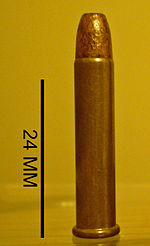 .22 WMR (Winchester Magnum Rifle) cartridges (https://en.wikipedia.org/wiki/.22_Winchester_Magnum_Rimfire) have been produced since 1960. The .22 WMR is, essentially, a 125-yard maximum PBR (that’s Point Blank Range and not Pabst Blue Ribbon) with 30-grain, 40-grain, and 50-grain hollow point bullets being its mainstay projectile.
.22 WMR (Winchester Magnum Rifle) cartridges (https://en.wikipedia.org/wiki/.22_Winchester_Magnum_Rimfire) have been produced since 1960. The .22 WMR is, essentially, a 125-yard maximum PBR (that’s Point Blank Range and not Pabst Blue Ribbon) with 30-grain, 40-grain, and 50-grain hollow point bullets being its mainstay projectile.
I have one .22 WMR handgun, an early version of the single-action Ruger Single-Six Convertible revolver that is far more accurate using .22 LR (Long Rifle) than using .22 WMR ammunition. There is also a Marlin 725Rm (magazine-fed) and a Marlin 983T (tube-fed) rifle in the stable, both of which are outfitted with fairly decent optics, but I have to say that they do not get a lot of use.
I recently wanted to become re-acquainted with the .22 WMR cartridge and there are a lot of quality firearms that chamber the cartridge, which means that you have to do a lot of research before deciding on what .22 WMR firearm to purchase, should you decide to purchase one for the first time, or even to be a return consumer to the cartridge like I am.
Although Ruger made an attempt at producing its 10/22 in .22 WMR, it was not a successful venture and the product was dropped from the Ruger line-up. The bolt gun lineup for the .22 WMR includes the Ruger American Rimfire Target, which became the object of my intention. You see, I just plain like bolt-guns for their simplicity, accuracy, and ease of maintenance. I also like wood furniture on my rifles and that pared the selection down a bit. Given a choice, the Ruger won out.

Ruger American Rimfire Target 22 WMR
The Basics:
While I am not a Ruger fan boy, for some reason most Ruger firearms appeal to me and I have a number of them in the stable. Like many, I find Ruger firearms to be robust and of reasonably high quality. I also like to buy firearms made in the U.S.A and Ruger fills the bill in that area.
The basics for the Ruger American Rimfire Target 22 WMR are shown below.


Optics Required!
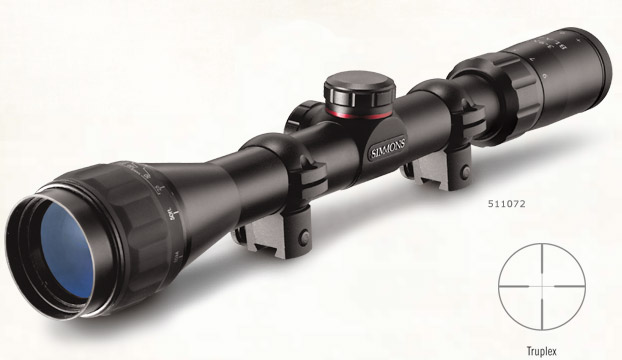 Obviously, the Ruger American Rimfire Target comes without sights, but is equipped with the Ruger aluminum version of the Picatinny rail. I had ordered the Simmons 511072 Matte 3–9x 32 AO scope to place on another rifle, but that endeavor did not work out. So, the scope found a home atop the Ruger. The scope was quickly mounted not using the scope rings that came with the Simmons, since the Ruger has a Picatinny-like rail and the scope rings were for a dovetail mount. I happened to have a set of scope rings that I have not yet identified what scope they came with, but they had all the necessary requirements to work. Normally, I like QD (Quick Detachable) scope rings, which these were not, but I do not anticipate removing the scope anytime soon – unless it just does not work out for me.
Obviously, the Ruger American Rimfire Target comes without sights, but is equipped with the Ruger aluminum version of the Picatinny rail. I had ordered the Simmons 511072 Matte 3–9x 32 AO scope to place on another rifle, but that endeavor did not work out. So, the scope found a home atop the Ruger. The scope was quickly mounted not using the scope rings that came with the Simmons, since the Ruger has a Picatinny-like rail and the scope rings were for a dovetail mount. I happened to have a set of scope rings that I have not yet identified what scope they came with, but they had all the necessary requirements to work. Normally, I like QD (Quick Detachable) scope rings, which these were not, but I do not anticipate removing the scope anytime soon – unless it just does not work out for me.
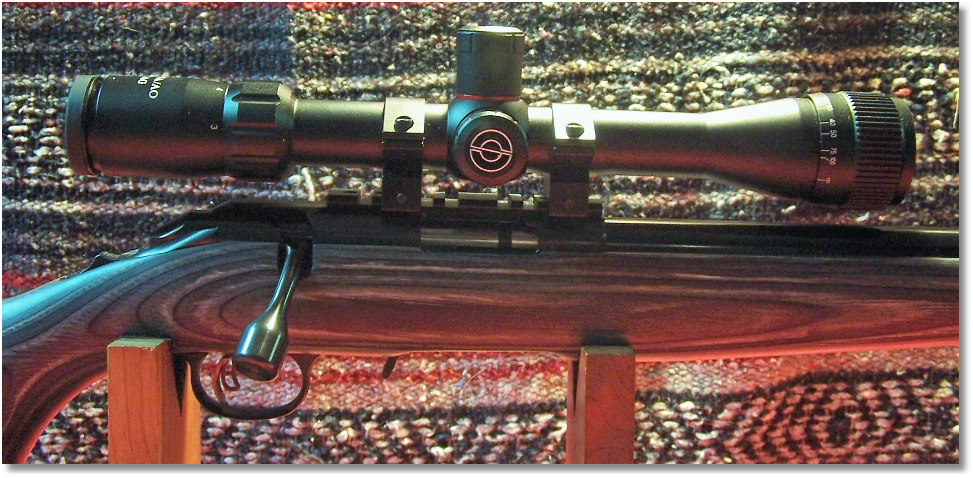
The Simmons 22 WMR AU Scope is a Nice Setup for this Firearm
Taking Stock

The Alexander Henry Forearm Design
As much as I am tired of black synthetic stocks, I am also tiring of black laminated stocks such as that on the Ruger American Rimfire Target 22 WMR. With that said the laminated wood stock is of high quality and has a very nice pattern to it. I have several rifles with laminated furniture and I favor them over the synthetic stocks regardless of the color. Well, maybe I won’t take it that far because some color combinations of lamination just don’t work for me. Fortunately, this one does and I have no plans to change it.
The stock is fully bedded and the threaded 18” target barrel is free-floating. The forearm of the stock features an Alexander Henry (https://en.wikipedia.org/wiki/Alexander_Henry_(gun_maker) ) forend that, according to some, is a love-hate relationship. I have no stock (no pun intended) in this argument.

Like my 2nd Wife, The Ruger Has a Well-padded stock to absorb the massive recoil from the 22 WMR
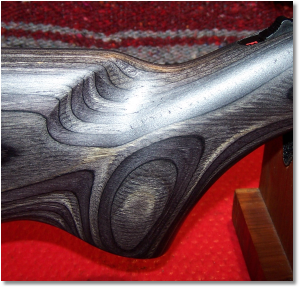
The Grip is Well-Formed with no Texturing
The laminated stock is well-formed and finished, but there are blemishes, as with most laminated stock. One has to remember that laminated stocks are built up in thin layers. I have seen laminated stocks with clear overcoats that tend to hide existing blemishes, but the blemishes are still there. If the stock of the Ruger has a protective finish, it is a satin-like finish that allows the natural beauty (and blemishes) to be revealed, but you have to look closely to see the blemishes. Overall, I give the stock a passing grade of “B” for effort, but definitely not an “A” grade. While the rifle may be sold as a “Target” firearm, I do see it being used for double-duty such as varmint and small game hunting when desired.
The stock also includes sling swivels mounts front (a quality bi-pod would be a good addition) and rear, and a soft rubber recoil pad that helps to anchor the rifle to the shoulder. Checkering is non-existent on the stock. The grip area has a nice angle and drop to it. In fact, when I hold the Ruger American Rimfire and the Ruger American Ranch carbine in 7.62×39, it is difficult to find any difference between the grip angles.
With a 13.75-inch Length of Pull, I find the rifle comfortable to hold, although I prefer a slightly longer LOP. With a scope of the proper eye relief mounted to the action, I find myself right at home and comfortable behind the Ruger.
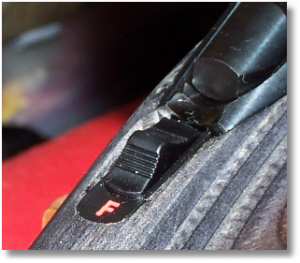
A Tang-Mounted Safety. A feature That I Definitely Like!
One feature that I especially like is the tang-mounted safety, and as a left-handed shooter it is in a very handy location. As I mentioned in my article about the Ruger American Ranch carbine in 7.62x39mm caliber, as a “lefty” you want to place the thumb along the stock when operating the bolt and not wrapped around the grip since the thumb interferes with the bolt coming rearward – something a right handed shooter need not care about.
Safety operation is simple – Push forward to fire and pull back to safe.
Heading to the Lock-Up!
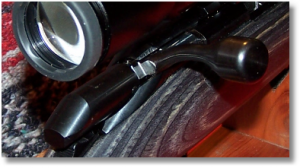
Plenty of Scope Clearance with the 60-degree Bolt
The bolt-handle seems long and the bolt knob large on this rifle. However, it does make for quick bolt operation. Like the Ruger American Ranch carbine, there is plenty of scope clearance, which was one reason for going to the Ruger rather than the CZ, although I do now know what works on a CZ.
The bolt is an interesting affair. Obviously robust, the bolt incorporates an extractor and opposing tension arm that hold the case firmly against the extractor. The ejector is incorporated in the receiver, under the bolt, and slightly off-center to the bolt face. On extraction, the bolt moves rearward and the ejector contact the base of the cartridge. As the ejector pushes against the case it forces the case out and away from the tension arm as the case pivots out of the extractor claw. All of this causes a very-positive ejection of the case out of the ejection port, which has a substantial opening.
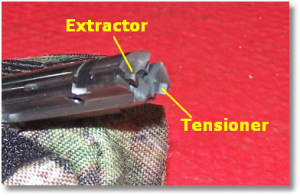
Bolt Face Showing Extractor and Tension Arm
The bolt works smooth and removes the cartridges from the JMX-1 rotary magazine quite well. The bolt also does an excellent job of removing spent shells from the chamber and throwing them out of the rifle as fast as you can work the bolt. The magazine was another feature of the Ruger American Rimfire Target. The JMX-1 magazine houses 9 rounds of .22WMr or 9 rounds of .17 HMR ammunition that provide a 9+1 capacity. Larger capacity magazines; however, are not available. Three spare magazines were ordered from Ruger since none could be found through other on-line distributors. Apparently, these magazines are popular – and they are not expensive like some that I know of.

Flush Fit Magazine – Fits 17 HMR and 22 WMR Cartridges
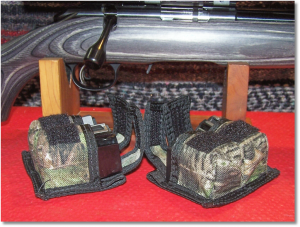
Speedloader Pouches Work Great to House Spare Magazines
The magazine is large and releases easily from the magazine well, although they are a tight fit at first. The magazines are flush-mount and blend in flush with the rifle. I also found out that a nylon speedloader pouch for a .38 special/.357 magnum will also house the Ruger magazine for the .22 magnum just as it does for the .22LR magazines. In fact, due to the longer length of the magazine, the magazine is easier to extract from the speedloader pouch than the .22LR magazine. If you are thinking about a way to transport spare magazines, these speed loader pouches would be an ideal means to do so.
The magazine release lever is substantial and operates in the forward direction; push the lever forward to release the magazine. If you are used to operating an AK magazine release, you should be able to quickly acclimate to using the one on this rifle.
The trigger on my unit is excellent and set at 3.6 pounds of pull, which I can adjust if I desired. However, I see no need for adjustment. I see more of a need to use it and let it break in naturally. Ruger claims an adjustment from 3 to 5 pounds. The Ruger Marksman Adjustable™ trigger has a lever located in the center of the trigger that must be pressed for the rifle to fire. This lever adds a bit of take-up on the trigger and I found mine to be slightly gritty at first but smoothed out after operating it for a while.
A Lot of Barrel to Roll Out
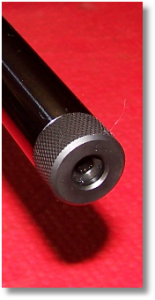
Threaded Barrel is a Big Plus. Note the Finish on the Barrel.
The target barrel contributes to the majority of the rifle’s weight of 6.7 pounds. Rather than the (what seems usual now) matte finish, the barrel is finished in a high gloss black with threaded adapter. The target-crowned exit point of the barrel is well protected. As was mentioned, the barrel is free-floating due to the patent-pending bedding that is incorporated in the stock. Although the .22 WMR round is more powerful than the .22 LR, the recoil is not and the heavy barrel keeps the muzzle jump to a minimum.
Less muzzle-jump equates to better follow through. That also means more time behind the lens as minimal muzzle jump keeps the scope from wavering from your line of sight through the scope. If you can work the bolt while peering through the scope, then it also means faster follow-up shots. In a timed event, being able to shoot quickly and accurately can mean a difference. In the hunting world, making a quick follow-up shot can make the difference with a varmint who has taken exception to you shooting them from chewing on your body.
The Shooting Show
The .22WMR has not been known for exceptional accuracy. With a 1:14 RH twist with 6 grooves, the heavy, 18-inch, cold hammer-forged barrel should have some degree of accuracy.
According to Ballistic By The Inch (http://ballisticsbytheinch.com/22mag.html) the CCI Maxi-Mag HP+V 30 gr. JHP should garner 2322fps out of an 18” barrel with almost 360 ft. pound of muzzle energy. That’s a honking little round, if I might say so. Note that CCI rates the cartridge at 2200 fps. It would be interesting to chronograph the round, but I do not have the means to do so.
Here are a few charts for you to peruse and ponder about.
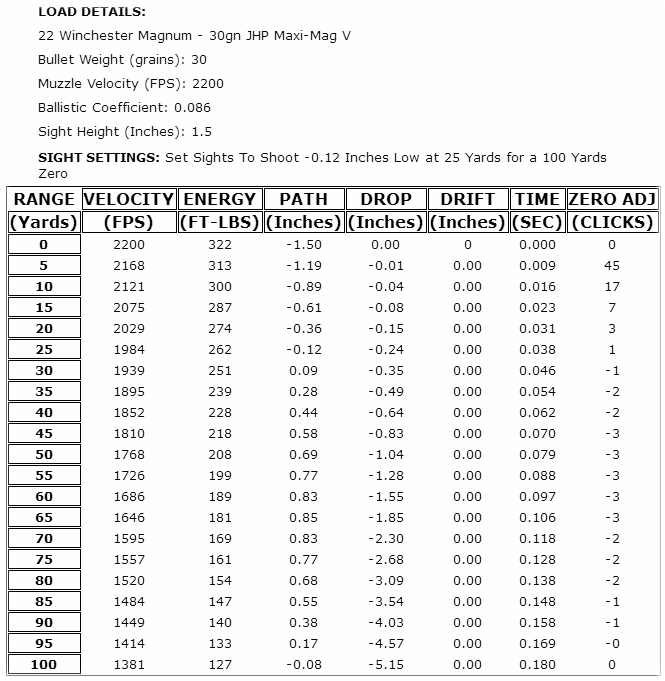
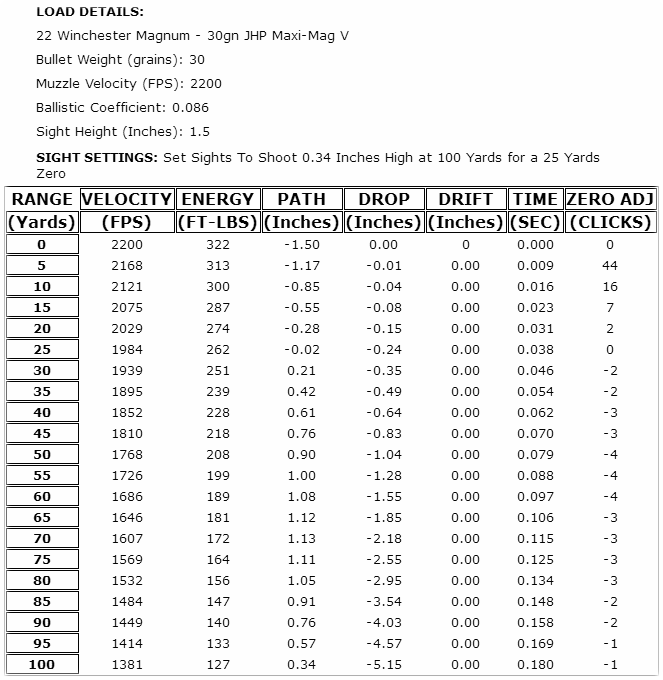
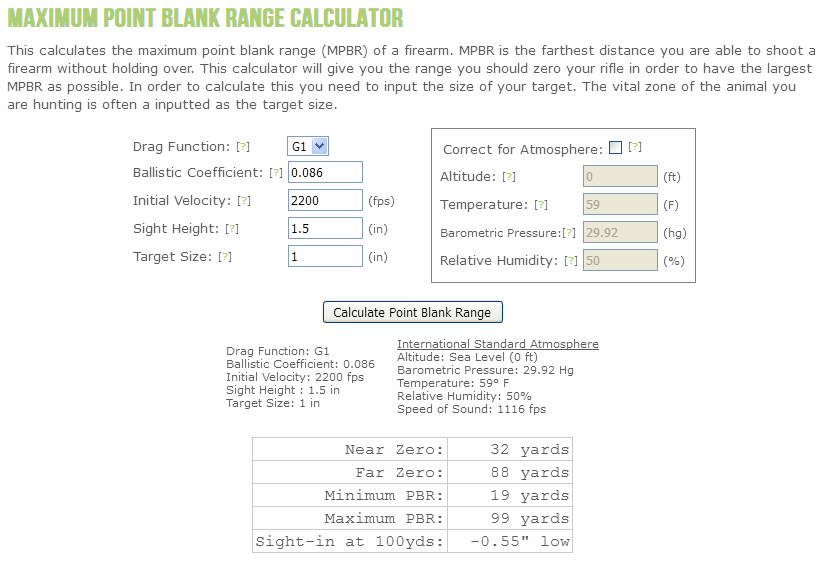
Wrangling the Range
The three spare magazines for the Ruger American Rimfire Target 22 WMR arrived a day before the scheduled range session for zeroing-in the firearm. So, I had four magazines and a fifty CCI MAXI-MAG 30-grain 22 WMR HP+V cartridges to play with. I don’t normally stock 22 WMR as they are the least of my shooting calibers, but that may change a bit in order to have a couple on hand for special occasions. I am not a hunter anymore and my shooting is primarily target.
I planned on zeroing at 25 yards and do some accuracy testing at that range to obtain an idea of the inherent precision of the Ruger American Rimfire Target 22 WMR as best as I could manage with old eyes, old age, and two cups of coffee working against me. While I was interested in “cold bore” accuracy, I was also interested in “warm bore” precision.
The trigger break is crisp, but was also slightly gritty when new; a few rounds of .22WMR ammunition were enough to begin smoothing it out. Once the slack is taken out of the trigger, it reminds me of a good, crisp 1911 trigger with not much of a wall to contend with.
I had a few FTEs (Failure To Extract), as the action is new and not yet broken in. I found that it was more my problem than the Ruger, as I was being wimpy chambering a round. I found that the harder and faster I slid and locked the bolt forward, FTEs were a non-issue.
Once the rifle was sighted in as close as I could get it, it was time to go for groups. My second group was good and I let a couple of shooting companions try their luck. Both put in good groups and then I moved on to putting together a final group before I called it a day.
The barrel had warmed up with the previous 27 rounds fired as I slid the last magazine with 9 rounds in place. The result of shooting the 9 rounds is shown below.

Nine Rounds of CCI MAXI-MAG 22 WMR HP+V @ 25 yards.
What resulted is a slightly less than a .25-inch group at 25 yards. When I pulled the target back in, I was surprised at the result. There is no doubt in my mind that the Ruger American Rimfire Target in .22 WMR is an accurate rifle.
What’s not to Like?
Two negative that I have found. One is that the magazine does not drop free, but has to be coaxed a bit. Although it releases from the rear after pushing the magazine release lever, it does hang up at the front. At times I had to push the magazine back into place, reach through the ejection port with two fingers, push the magazine release lever forward, and then push down with two fingers against the top of the magazine to get it to drop out. This may change as the rifle and the magazines wear against each other, but for now it is aggravating.
The second negative is the FTE (Failure To Extract) issue, although I think that this could be a fault of mine for not properly cycling the action. Like a lever-gun, cycling the action needs to be swift and sure to ensure proper chambering and proper extraction/ejection. I may also try some brass-cased ammunition to see if there is a difference from what I was experiencing with the CCI ammunition.
Actually, there is a third negative; repeatedly typing Ruger American Rimfire Target 22 WMR is tiring my fingers.
There is something about working a bolt or lever than unites the shooter with the firearm; the interaction between man and machine – like working the clutch on a motorcycle or in a truck or car with a standard transmission. There is a sense of satisfaction and control with that small bit of human input to make a piece of equipment respond. I guess that’s why I like bolt-operated long guns over most. If you like bolt-guns and the .22WMR cartridge, you would be hard-pressed to find anything not to like with the Ruger American Rimfire Target in .22WMR.
References:
- .22 WMR (Winchester Magnum Rifle): https://en.wikipedia.org/wiki/.22_Winchester_Magnum_Rimfire
- Ruger American Rimfire Target in .22WMR: https://ruger.com/products/americanRimfireTarget/specSheets/8349.html
- Simmons 3-9×32 A) .22 Mag Scope: http://simmonsoptics.com/riflescopes/22_mag.aspx
- MPBR Calculator: http://www.shooterscalculator.com/point-blank-range.php?df=G1&bc=0.086&vi=2200&sh=1.5&ts=4
![]()

